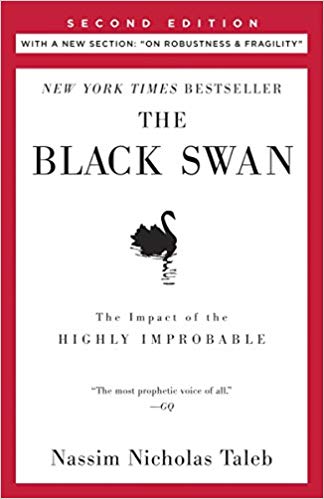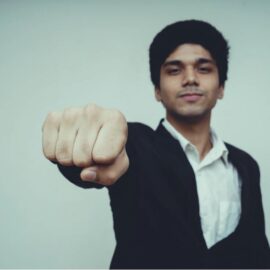

This article is an excerpt from the Shortform summary of "The Black Swan" by Nassim Taleb. Shortform has the world's best summaries of books you should be reading.
Like this article? Sign up for a free trial here .
No one can predict the future. But why? Why are some situations and events more predictable than others?
We’ll cover the nature of predictability according to Nassim Nicholas Taleb and look at why it is that no one can predict the future.
No One Can Predict the Future: Why Not?
Taleb, however, offers a new spin on the term “black swan”. He uses it to describe specific historical events with specific impacts. These events have three salient features:
- They are “outliers” (that is, they are statistically insignificant);
- They have profound real-world impacts; and
- Despite (or perhaps because of) their extreme unpredictability, they compel human beings to account for them—to explain after the fact that they were in fact predictable.
Some examples of Black Swan events include World Wars I and II, the fall of the Berlin Wall, 9/11, the rise of the Internet, the stock-market crash of 1987, and the 2008 financial crisis. Black swans are one of the reasons that no one can predict the future.
Taleb’s thesis is that Black Swans, far from being insignificant or unworthy of systematic study, comprise the most significant phenomena in human history. We should study them, even if we can’t predict them. Thus, counter-intuitively, we would be better served by concentrating our intellectual energies on what we don’t—nay, can’t—know, rather than on what we do and can know.
Taleb also claims, also counter-intuitively, that the more our knowledge advances, the more likely we are to be blindsided by a Black Swan. This is because our knowledge is forever becoming more precise and specific and less capable of recognizing generality—for example, the general tendency for earth-shattering events to be completely unforeseen (which, of course, is why they’re earth-shattering).
The Unreliability of “Experts”
Even though no one can predict the future, many people try to. Taleb has very little patience for “experts”—academics, thought leaders, corporate executives, politicians, and the like. Throughout the book, Taleb illustrates how and why “experts” are almost always wrong and have little more ability to predict the future than the average person.
There are two reasons “experts” make bad predictions and no one can predict the future:
1) Human Nature
Because of various habits innate to our species—our penchant for telling stories, our belief in cause and effect, our tendency to “cluster” around specific ideas (confirmation bias) and “tunnel” into specific disciplines or methods (specialization)—we tend to miss or minimize randomness’s effect on our lives. Experts are no less guilty of this blindspot than your average person. This is one reason no one can predict the future.
2) Flawed Methods
Because experts both (1) “tunnel” into the norms of their particular discipline and (2) base their predictive models exclusively on past events, their predictions are inevitably susceptible to the extremely random and unforeseen.
Consider, for example, a financial analyst predicting the price of a barrel of oil in ten years. This analyst may build a model using the gold standards of her field: past and current oil prices, car manufacturers’ projections, projected oil-field yields, and a host of other factors, computed using the techniques of regression analysis. The problem is that this model is innately narrow. It can’t account for the truly random—a natural disaster that disrupts a key producer, or a war that increases demand exponentially.
Taleb draws a key distinction between experts in Extremistan disciplines (economics, finance, politics, history) and Mediocristan disciplines (medicine, physical sciences). Experts like biologists and astrophysicists are able to predict events with fair accuracy; experts like economists and financial planners are not.
Difficulties of Prediction
The central problem with experts is their uncritical belief in the possibility of prediction, despite the mountain of evidence that indicates prediction is a fool’s errand and that no one can predict the future. Some key illustrations of the futility of prediction include:
Discoveries
Most groundbreaking discoveries occur by happenstance—luck—rather than careful and painstaking work. The quintessential example is the discovery of penicillin. Discoverer Alexander Fleming wasn’t researching antibiotics; rather, he was studying the properties of a particular bacterium. He left a stack of cultures lying out in his laboratory while he went on vacation, and when he returned he found that a bacteria-killing mold had formed on one of the cultures. Voilá—the world’s first antibiotic.
Dynamical Systems
A dynamical system is one in which an array of inputs affect each other. Whereas prediction in a system that contains, say, two inputs, is a simple affair—one need only account for the qualities and behavior of those two inputs—prediction in a system that contains, say, five hundred billion inputs is effectively impossible. Because we live in a dynamical system, no one can predict the future.
———End of Preview———

Like what you just read? Read the rest of the world's best summary of "Black Swan" at Shortform . Learn the book's critical concepts in 20 minutes or less .
Here's what you'll find in our full Black Swan summary :
- Why world-changing events are unpredictable, and how to deal with them
- Why you can't trust experts, especially the confident ones
- The best investment strategy to take advantage of black swants






